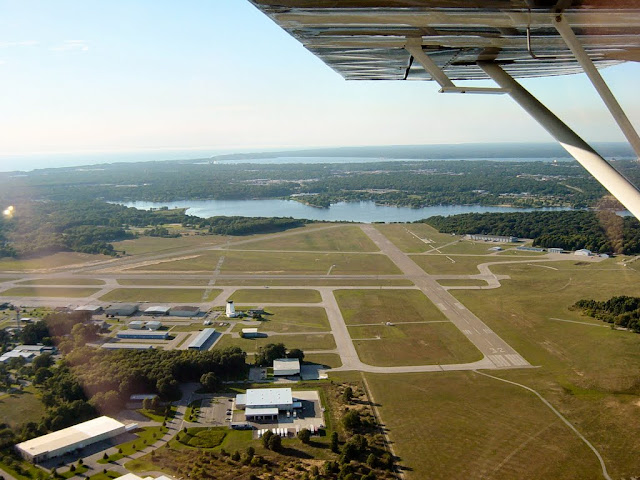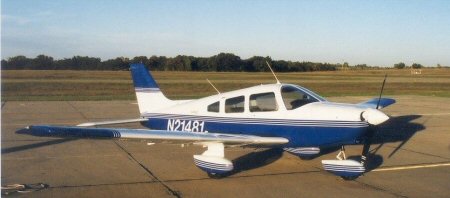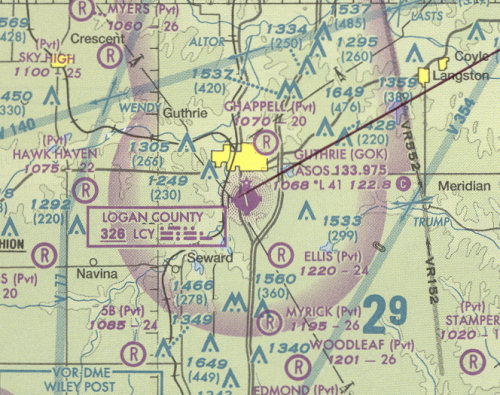| Date | Aircraft | Route of Flight | Time (hrs) | Total (hrs) |
| 01 Sep 2004 | N21481 | MKG (Muskegon, MI) - 0D1 (South Haven, MI) | 0.6 | 239.0 |
Achilles Heel
The thrum of the Super Decathlon's engine occasionally intensified, reverberating through my skull with increased vigor whenever my headset made contact with the airplane's headliner. Off my left shoulder, the high wing with its psuedo-Normandy stripes projected into a cobalt void; cerulean above and turquoise below where the waters of Lake Michigan met the cloudless sky at the horizon. Below the starboard wing rolled a green expanse of shoreline, demarcated from the lake by a brilliant line of sandy beach that glowed under the evening sun.
 |
| Big Red and the pier at Holland, MI |
I was an aeronautical hitchhiker, riding in the back of Dave's Decathlon on a thirty minute flight along the lakeshore from our home base in South Haven to Muskegon. My Piper Warrior, purchased earlier that year, was ready to come home from Muskegon after a radio repair.
My airplane's avionics suite was a modest affair, primarily comprising a pair of Bendix/King KX-170B nav/com radios. Though old - one of them was built before my wife was born - the words "reliable" and "bulletproof" are often used to describe these venerable units. But they have an Achilles Heel, a delicate wafer switch integral to the tuner. One of mine had cracked, leading to signal degradation on several frequencies. The good folks at Hillview Avionics in Muskegon did the repair. Though much cheaper than investing in new radios, this was nevertheless a costly venture. I suspect that labor was a significant factor: the KX-170B is the size of a shoebox and packed to capacity with solid state circuitry.
Muskegon Approach handed Dave off to the tower and we were instructed to enter a left downwind for runway 24. As we rolled onto the pavement, I spotted my Warrior in its Matterhorn White and Fighter Blue color scheme parked close to Hillview's hangar.
 |
| Decathlon 68W on downwind for runway 24 at MKG |
Formed Up
With the Warrior's engine humming on the ramp, I listened to Muskegon's tower, approach, and ATIS frequencies. All were clear as a bell and I concluded that the repair had been a success. A few minutes later, I was climbing away from Muskegon and turning south along the shoreline. Cruising at 3000' along Lake Michigan, I heard Dave check in with the departure controller who warned him that I was a few miles ahead. There was surprisingly little air traffic that night and departure did not advise me of any airborne targets before terminating radar services at the usual spot near Holland. I remained on departure frequency long enough to hear the controller drop Dave from the system, then I toggled to an air-to-air channel and waited.
"Warrior 481, are you on frequency?" came Dave's query. I responded that I was.
"Mind if I form up?" This was a common question whenever we flew together. Dave had training and experience in formation flight. I trusted him and was comfortable allowing the Decathlon into the little bubble of personal space surrounding my airplane. Not having any formal formation training myself, I always flew in the lead position where it was my job to navigate, watch for traffic, and not make any abrupt, unexpected maneuvers. It was Dave's job to park himself off my wing and focus most of his attention on the spacing between our aircraft. I took my portion of this partnership very seriously. One of our fellow pilots once deliberately passed too close to a tiny cloud with Dave on his wing, giving Dave a nasty surprise when he found himself in a cloud for a couple of seconds. Indeed, I tried very hard not to surprise the guy flying close to my airplane.
 |
| Dave in the Decathlon in formation with Warrior 481 on April 14, 2004 |
"Absolutely," I responded and throttled back to allow the Decathlon to catch up. Despite its more powerful engine, the Decathlon's airframe possessed more form drag than the Warrior such that we were well matched in cruise speed.
"Can you give me a gentle turn to the right?" I clicked the microphone twice in acknowledgement and banked gradually toward the lake. This would help him to complete the join up. In my peripheral vision, I saw the Decathlon appear at my four-o-clock. Though we had done this many times, I remained fascinated by the join up. With both of our airplanes turning in tandem, the Decathlon moved into position off my starboard rear quarter. The maneuver was so smooth, the relative motion so minor, it seemed as though the other airplane slid along a rail projecting rearward from my fuselage at a 45 degree angle. With Dave tucked in close, the Lake Michigan shoreline reappeared under my nose and I leveled the wings to continue south. The Decathlon moved in synchronicity as Dave executed a series of minor power and attitude adjustments to create the illusion that his aircraft was fixed to mine through a rigid, if intangible, beam.
Radio Silence
Formed up, we continued south along the shoreline for a couple of minutes before Dave called again, "want to do some shallow turns?"
"Ok. Let me know when you're ready," I answered.
Radio silence persisted longer than I expected. "Do you want to do some turns?" Dave repeated. I echoed my previous response. Another minute passed before I heard from Dave again.
"I am not receiving you. I can hear traffic on Unicom, so I know that my receiver is working. Can you hear me?"
Without thinking about it, I responded affirmatively on the radio as my glance swept the instrument panel. Nothing appeared awry and I could still hear my voice amplified over the Warrior's intercom system. Realizing that I probably had a transmitter problem and that Dave did not hear me, I looked over my shoulder and gave an exaggerated nod toward the Decathlon hovering a few yards away . Formation flying experts often rely on hand signals to communicate with their wingmen, but I was not a formation flying expert and the only hand signals I knew would not have been productive in this scenario (if ever).
"Ok, I'm going to back off and give you more space, but we should head straight back to South Haven now."
I agreed, though verbalization at this point was obviously fruitless. My mind immediately fixated on the work just completed by Hillview Avionics and I became certain that the repair must have caused some new problem.
Then the audio panel went crazy with marker beacon lights flashing randomly. The cabin's overhead speaker kvetched loudly, emitting a series of loud crackling sounds punctuated with headache inducing squeals. With the overhead speaker switched off at the audio panel, it should not have been making any noise at all.
Now I was angry. What did those guys do to my airplane?
Fortunately, I did not need a radio to land at South Haven. This problem was a nuisance, not a catastrophe. Just a few miles north of South Haven, I tuned to 122.80 and listened. Student traffic at Allegan dominated the frequency, but I heard no transmissions from South Haven. If there were any airplanes in the pattern there, they were just as radio silent as I was.
With the overhead speaker still voicing shrill complaints, I entered the pattern at South Haven. On final approach, my radio suddenly died entirely, right in the middle of a pilot broadcasting a bandwidth-wasting entreaty for any traffic in the pattern at Allegan to "please advise".
"Oh, that's f@#%ing terrific," I said aloud to no one. But this time, I did not hear my words amplified back at me in the headset, which meant that the intercom was now offline. I landed and cleared the runway, seething over what I was convinced to be a botched avionics repair. Outside my hangar, I switched off the transponder and avionics master switch. Moving to kill the strobe lights and beacon, I saw something that made me pause.
Alternate Causality
Any experienced pilot reading this account has no doubt already guessed what really happened. It had nothing to do with the work done by Hillview Avionics. In fact, as far as I can tell, their work was beyond reproach.
As I was shutting the airplane down, I glanced at the ammeter situated on the lower right side of the Warrior's instrument panel (left of the circuit breakers as shown in the photo below). It was pegged at zero, indicating that the alternator was not providing current to support the electrical demand. I did not have an avionics problem, the entire electrical system was dead.
Once the Warrior's cowling was removed, the cause of the failure was obvious. Piper was using 1970s era Chrysler alternators in their production aircraft when N21481 rolled off the Vero Beach assembly line. An integral part of my Chrysler alternator's cast aluminum housing that attached to the front of the engine had cracked off, obviously a victim of metal fatigue. While the airplane logbooks describe the alternator being overhauled in the past, the housing was probably original. After 25 years of abuse on the front of a vibrating airplane engine, it had obviously lost the will to live and literally shook itself to pieces. The guts of the poor device were a mess.
With this understanding, the evening's events all fell into place. I had probably launched into the Muskegon sky with a functional alternator - I believe this because I had checked the ammeter during engine run up. At some point, however, the alternator gave up and the battery was on its own to support the power demands of radios, transponder, strobe lights, and other electrical devices. Fortunately, all systems continued working while I was within Muskegon's airspace; I had two way radio contact with Muskegon departure and they were reading my transponder.
Without support from the alternator, the battery quickly discharged. Requiring more power than any other device on board, the radio transmitter failed first as it greedily siphoned current from the failing battery. From there, other systems shut down as battery power dwindled. Had Dave and I not flown back to South Haven together in radio contact, I would have never known that my transmitter failed.
Upon discovery of the radio problem, I became so focused on its apparent correlation with the recent radio work that my brain disengaged from any further troubleshooting of the problem. Had I simply looked at it, the ammeter would have told me all I needed to know. Although there is also an "ALT" annunciator (idiot light) on the panel, its dim orange glow would have been washed-out by the ochre sunset spilling across the instruments at the time.
 |
| My panel as it looked on that day. |
As often occurred during that first year of aircraft ownership, this incident imparted some valuable lessons. I am far more careful about including the ammeter in my scan of the panel. I suspect it knows that I have my eye on it; it has not demonstrated any aberrant behavior ever since. My preflight tugs on the alternator belt are more aggressive and I always check the security of the ammeter itself by giving the housing a good shake.
Perhaps most importantly, I learned a lesson about fixating too quickly on a perceived root cause while ignoring the rest of the clues provided by the airplane. Had I diagnosed an alternator failure while still aloft, I could have shut down non-essential electrical systems (e.g., intercom, strobes, transponder) and saved my radio for the landing at South Haven.
I remember learning in ground school how aircraft ignition systems received that altitude-critical spark from magnetos rather than the potentially fickle electrical system. At the time, it seemed a very clever idea. Now I am sure of it. Magnetos might represent old technology, but I am a huge fan of them.


















































